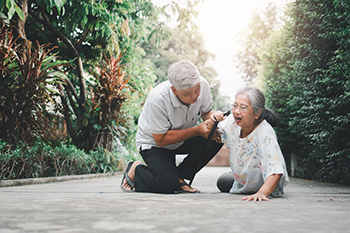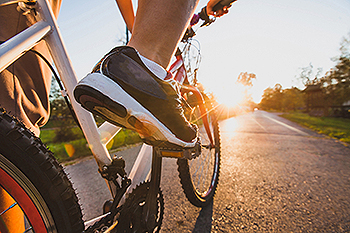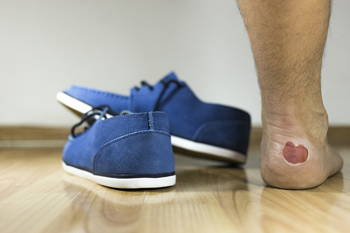Connect With Us
Blog
Items filtered by date: August 2022
What Is Charcot Foot?

Charcot foot is a condition that causes weakened bones in the foot. This can occur in people who have significant nerve damage or neuropathy in the foot. Neuropathy decreases sensation and the ability to feel temperature, pain, or trauma. Because of this, a person with Charcot foot may continue walking and exacerbate the condition. The bones become weak enough to break, and if walking is continued, the foot will eventually change shape. As time goes on, the condition causes joints to collapse and the foot to take on an abnormal shape, like a rocker-bottom appearance. If one has this ailment, they will feel warmth in the affected foot, notice redness and swelling in the area, and experience pain or soreness. It is a serious condition that can lead to disability and even amputation. Those who have diabetes, a disease often associated with neuropathy, or those with a tight Achilles tendon are at more risk for developing Charcot foot and should take preventative measures. You should contact a podiatrist as soon as signs or symptoms appear, as successful treatment is dependent on early diagnosis.
Some foot conditions may require additional professional care. If you have any concerns, contact one of our podiatrists of Comprehensive Foot & Ankle Centers. Our doctors can provide the care you need to keep you pain-free and on your feet.
Rare Foot Conditions
The majority of foot conditions are common and can be treated by a podiatrist. Standard diagnostic procedures are generally used to identify specific conditions and treatment can be rendered. A podiatrist also treats rare foot conditions which can be difficult to diagnose and may need extra attention and care.
There are many rare foot conditions that can affect children. Some of these can include:
- Freiberg’s disease
- Kohler’s disease
- Maffucci syndrome
Freiberg’s disease - This can be seen as a deterioration and flattening of a metatarsal bone that exists in the ball of the foot. It typically affects pre-teen and teenage girls, but can affect anyone at any age. Symptoms that can accompany this can be swelling, stiffness, and the patient may limp.
Kohler’s disease - This often targets the bone in the arch of the foot and affects younger boys. It can lead to an interruption of the blood supply which ultimately can lead to bone deterioration. The patient may limp or experience tenderness, swelling, and redness.
Maffucci syndrome - This affects the long bones in a child’s foot leading to the development of abnormal bone lesions. They are benign growths and typically develop in early childhood and the bones may be susceptible to breaking.
A podiatrist can properly diagnose and treat all types of rare foot conditions. If your child is affected by any of these symptoms or conditions, please don’t hesitate to call our office so the correct treatment method can begin.
If you have any questions please feel free to contact our offices located in Shepherdsville and Louisville, KY . We offer the newest diagnostic tools and technology to treat your foot and ankle needs.
Ways Seniors Can Help Prevent Falls

As a person ages, the chance of falling increases along with the repercussions. Some serious dangers that may result from a fall include a broken hip, a broken wrist, or a head injury. Since the bones are thinner and more brittle, healing can take longer. A fall may also affect a senior’s ability to live alone as well as cause chronic pain and depression. A few ways that seniors can prevent falls are by keeping the body active, having their eyes checked for vision problems, and reviewing medications for side effects. In addition, safeguarding the home by removing loose rugs, installing handrails, and improving lighting in hallways or bedrooms is recommended. Other ways to prevent falls are to install grab bars in bathrooms and use a walker or cane for balance. Wearing shoes with non-skid soles can keep you from slipping or sliding on a polished floor. Foot and ankle symptoms like numbness, tingling, and swelling can contribute to a loss of balance or stability. Please visit a podiatrist for foot and ankle strengthening exercises, as well as other information on how to protect yourself from a fall.
Preventing falls among the elderly is very important. If you are older and have fallen or fear that you are prone to falling, consult with one of our podiatrists from Comprehensive Foot & Ankle Centers. Our doctors will assess your condition and provide you with quality advice and care.
Every 11 seconds, an elderly American is being treated in an emergency room for a fall related injury. Falls are the leading cause of head and hip injuries for those 65 and older. Due to decreases in strength, balance, senses, and lack of awareness, elderly persons are very susceptible to falling. Thankfully, there are a number of things older persons can do to prevent falls.
How to Prevent Falls
Some effective methods that older persons can do to prevent falls include:
- Enrolling in strength and balance exercise program to increase balance and strength
- Periodically having your sight and hearing checked
- Discuss any medications you have with a doctor to see if it increases the risk of falling
- Clearing the house of falling hazards and installing devices like grab bars and railings
- Utilizing a walker or cane
- Wearing shoes that provide good support and cushioning
- Talking to family members about falling and increasing awareness
Falling can be a traumatic and embarrassing experience for elderly persons; this can make them less willing to leave the house, and less willing to talk to someone about their fears of falling. Doing such things, however, will increase the likelihood of tripping or losing one’s balance. Knowing the causes of falling and how to prevent them is the best way to mitigate the risk of serious injury.
If you have any questions, please feel free to contact our offices located in Shepherdsville and Louisville, KY . We offer the newest diagnostic and treatment technologies for all your foot care needs.
Wounds That Don't Heal Need to Be Checked
Falling Can Lead to an Ankle Sprain

A common injury many people incur is called an ankle sprain. It is defined as a musculoskeletal injury that partially or fully tears the ligaments as a result of a sudden mishap. The ankle can severely twist by unexpectedly stepping off a curb or walking on an uneven surface. There may be a popping noise that happens at the time of the sprain and prompt medical attention is often needed. Additional symptoms can include swelling or bruising to the affected area, and it may be difficult to walk. Treatment often begins with elevating the sprained ankle as this can help to reduce swelling. The ankle may also feel better when it is wrapped with a compression bandage and crutches may be recommended that can help with completing daily activities. As the foot heals, there are specific stretches that can be practiced that can strengthen the ankle. If you have twisted your ankle or suspect it might be sprained, please confer with a podiatrist who can help you with effective treatment options.
Ankle sprains are common but need immediate attention. If you need your feet checked, contact one of our podiatrists from Comprehensive Foot & Ankle Centers. Our doctors can provide the care you need to keep you pain-free and on your feet.
How Does an Ankle Sprain Occur?
Ankle sprains take place when the ligaments in your ankle are torn or stretched beyond their limits. There are multiple ways that the ankle can become injured, including twisting or rolling over onto your ankle, putting undue stress on it, or causing trauma to the ankle itself.
What Are the Symptoms?
- Mild to moderate bruising
- Limited mobility
- Swelling
- Discoloration of the skin (depending on severity)
Preventing a Sprain
- Wearing appropriate shoes for the occasion
- Stretching before exercises and sports
- Knowing your limits
Treatment of a Sprain
Treatment of a sprain depends on the severity. Many times, people are told to rest and remain off their feet completely, while others are given an air cast. If the sprain is very severe, surgery may be required.
If you have suffered an ankle sprain previously, you may want to consider additional support such as a brace and regular exercises to strengthen the ankle.
If you have any questions please feel free to contact our offices located in Shepherdsville and Louisville, KY . We offer the newest diagnostic and treatment technologies for all your foot and ankle needs.
Morton’s Neuroma in Cycling

If you feel pain or numbness near the ball of your foot, under your toes, you may have a Morton’s neuroma. People sometimes describe this as feeling like there is a pebble or rock under their toes. Others describe it as a burning sensation, a sharp pain, or numbness in this area of their foot. A Morton’s neuroma is a thickening of the tissue around the nerves leading to the toes. Pain is usually felt between the 3rd and 4th toe or the ball of the foot between the 2nd and 3rd toes. It is a benign condition. A Morton’s neuroma can happen from wearing tight or high-heeled shoes. In cycling, shoes are usually lower volume, and these could pinch the toes together for prolonged periods depending on the length of your ride. This puts cyclists at a higher risk for this problem. Other causes of Morton’s neuroma include foot abnormalities, such as bunions, hammertoes, or flat feet. It can also be caused by repeated trauma from the feet pounding on pavement like in running, and as related to cycling when the foot tilts as it connects with the pedal of the bike. Make sure your cycling shoes are well-fitted. The toe box should be wide enough to allow toes to move freely and with a proper tilt. A wedge can be used to reduce pressure under the first two toes and help to relieve discomfort. If you are a cyclist and are experiencing the kind of pain described above, consider seeing a podiatrist for proper diagnosis and treatment that best suits you.
Ankle and foot injuries are common among athletes and in many sports. They can be caused by several problems and may be potentially serious. If you are feeling pain or think you were injured in a sporting event or when exercising, consult with one of our podiatrists from Comprehensive Foot & Ankle Centers. Our doctors will assess your condition and provide you with quality foot and ankle treatment.
Common Injuries
The most common injuries that occur in sporting activities include:
- Achilles Tendonitis
- Achilles Tendon Rupture
- Ankle Sprains
- Broken Foot
- Plantar Fasciitis
- Stress Fractures
- Turf Toe
Symptoms
Symptoms vary depending upon the injury and in some cases, there may be no symptoms at all. However, in most cases, some form of symptom is experienced. Pain, aching, burning, bruising, tenderness, tightness or stiffness, sensation loss, difficulty moving, and swelling are the most common symptoms.
Treatment
Just as symptoms vary depending upon the injury, so do treatment options. A common treatment method is known as the RICE method. This method involves rest, applying ice, compression and elevating the afflicted foot or ankle. If the injury appears to be more serious, surgery might be required, such as arthroscopic or reconstructive surgery. Lastly, rehabilitation or therapy might be needed to gain full functionality in the afflicted area. Any discomfort experienced by an athlete must be evaluated by a licensed, reputable medical professional.
If you have any questions, please feel free to contact our offices located in Shepherdsville and Louisville, KY . We offer the newest diagnostic and treatment technologies for all your foot care needs.
Shoes, Socks, and Blisters

A blister on the foot often develops as a result of excess friction that can come from wearing shoes and socks that do not fit correctly. It is defined as a small area that resembles a bubble and is filled with a serum that contains antibodies. When a blister forms, it is the body’s natural defense technique in protecting the raw skin, and will gradually drain as new skin develops. Additional reasons a blister may form can include allergic reactions to an insect bite, or existing medical conditions that can consist of eczema and psoriasis. Many people have abnormal foot shapes which may affect the fit of the shoe, possibly leading to a blister forming. Patients who have peripheral neuropathy or diabetes may be unaware of a rubbing sensation on their feet as a result of the inability to feel pain. It is important to refrain from popping the blister, which may result in infection and damage to the raw skin underneath it. If you have a blister on your foot, please consult with a podiatrist who can help you to properly manage it, and guide you toward preventing future blisters from developing.
Blisters may appear as a single bubble or in a cluster. They can cause a lot of pain and may be filled with pus, blood, or watery serum. If your feet are hurting, contact one of our podiatrists of Comprehensive Foot & Ankle Centers. Our doctors can provide the care you need to keep you pain-free and on your feet.
Foot Blisters
Foot blisters are often the result of friction. This happens due to the constant rubbing from shoes, which can lead to pain.
What Are Foot Blisters?
A foot blister is a small fluid-filled pocket that forms on the upper-most layer of the skin. Blisters are filled with clear fluid and can lead to blood drainage or pus if the area becomes infected.
Symptoms
(Blister symptoms may vary depending on what is causing them)
- Bubble of skin filled with fluid
- Redness
- Moderate to severe pain
- Itching
Prevention & Treatment
In order to prevent blisters, you should be sure to wear comfortable shoes with socks that cushion your feet and absorb sweat. Breaking a blister open may increase your chances of developing an infection. However, if your blister breaks, you should wash the area with soap and water immediately and then apply a bandage to the affected area. If your blisters cause severe pain it is important that you call your podiatrist right away.
If you have any questions, please feel free to contact our offices located in Shepherdsville and Louisville, KY . We offer the newest diagnostic and treatment technologies for all your foot care needs.
Blog Archives
- July 2025
- June 2025
- May 2025
- April 2025
- March 2025
- February 2025
- January 2025
- December 2024
- November 2024
- October 2024
- September 2024
- August 2024
- July 2024
- June 2024
- May 2024
- April 2024
- March 2024
- February 2024
- January 2024
- December 2023
- November 2023
- October 2023
- September 2023
- August 2023
- July 2023
- June 2023
- May 2023
- April 2023
- March 2023
- February 2023
- January 2023
- December 2022
- November 2022
- October 2022
- September 2022
- August 2022
- July 2022
- June 2022
- May 2022
- April 2022
- March 2022
- February 2022
- January 2022
- December 2021
- November 2021
- October 2021
- September 2021
- August 2021
- July 2021
- June 2021
- May 2021
- April 2021
- February 2021
- January 2021
- December 2020

